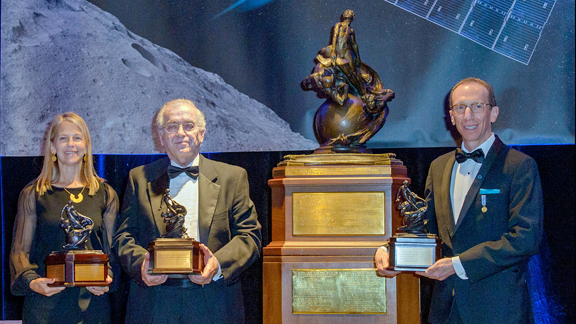
NASA's Dawn Mission, representing the first spacecraft to orbit two extraterrestrial targets, was honored with the National Aeronautic Association Robert J. Collier Trophy at a presentation in Arlington, Virginia, on Thursday, June 9, 2016.

Annual Robert J. Collier Trophy Dinner on Thursday, June 9, 2016 in Arlington, Virginia.
NASA Deputy Administrator Dr. Dava Newman, left, Dr. Charles Elachi, Director of NASA's Jet Propulsion Laboratory, center, and Dr. Marc Rayman, Dawn Mission Director and Chief Engineer at NASA's Jet Propulsion Laboratory, right, accept the 2015 Robert J. Collier Trophy on behalf of the NASA/JPL Dawn Mission Team. The Collier Trophy is awarded annually for the greatest achievement in aeronauts or astronautics in America.
Photo is courtesy of NASA/Joel Kowsky.
The award, presented annually, was given to Dawn Mission "In recognition of the extraordinary achievements of orbiting and exploring protoplanet Vesta and dwarf planet Ceres, and advancing the nation's technological capabilities in pioneering new frontiers in space travel."
The 8 foot tall (2.4 meter) trophy resides at the Smithsonian National Air and Space Museum in Washington and is engraved with the names of recipients. Dawn competed with a field of nine finalists to win this year's award. Dawn's mission is managed by NASA's Jet Propulsion Laboratory, Pasadena, California, for NASA's Science Mission Directorate in Washington. Previous Collier Trophy recipients involving JPL missions include the teams from NASA's Mars Science Laboratory (2012) and Voyager (1980).
NASA Deputy Administrator, Dava Newman, said, "This mission isn't only for scientists. It's for all of us who want to discover the nature of uncharted worlds and share that discovery with all who gaze up at the night sky in wonderment."
Dawn is a project of NASA's Science Mission Directorate Discovery Program, managed by NASA's Marshall Space Flight Center in Huntsville, Alabama. UCLA is responsible for overall Dawn mission science. Orbital ATK Inc., in Dulles, Virginia, designed and built the spacecraft. The German Aerospace Center, Max Planck Institute for Solar System Research, Italian Space Agency and Italian National Astrophysical Institute are international partners on the mission team.
JPL is a division of the California Institute of Technology in Pasadena, California.
For a complete list of mission participants, visit: http://dawn.jpl.nasa.gov/mission
More information about Dawn is available at the following sites:
and

